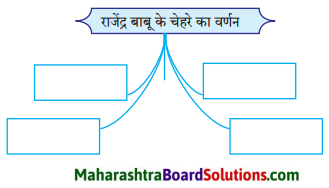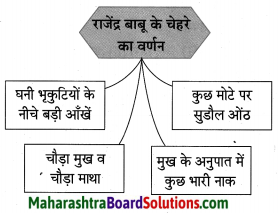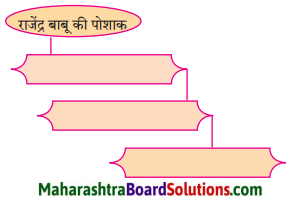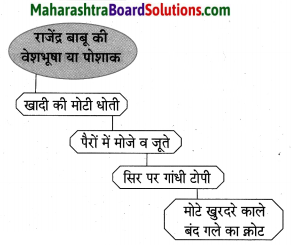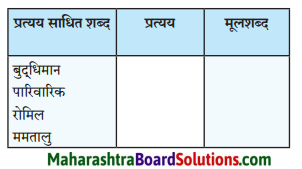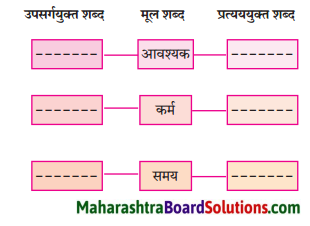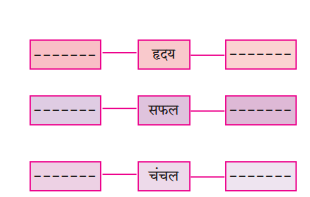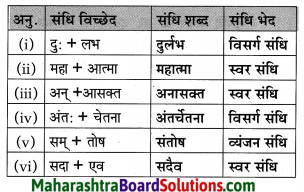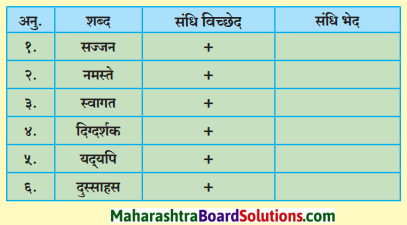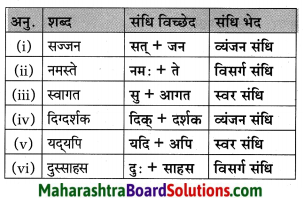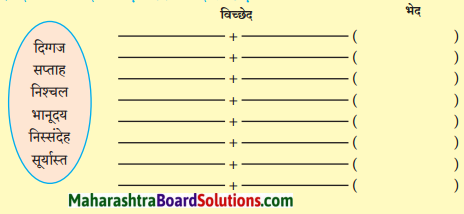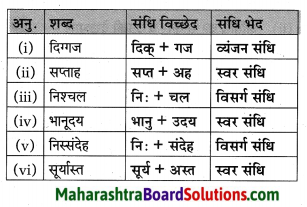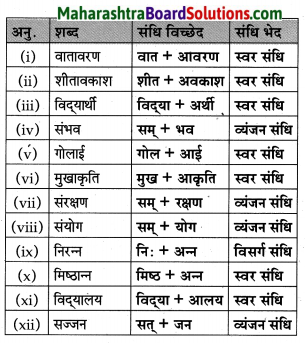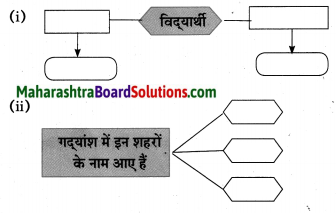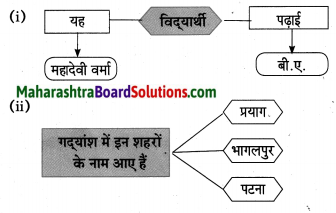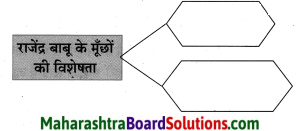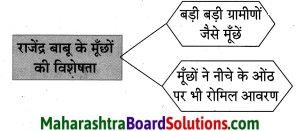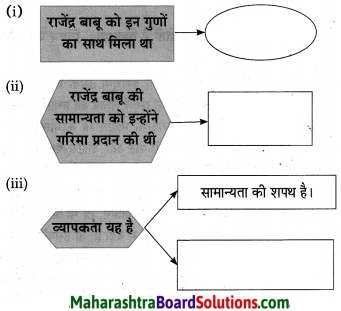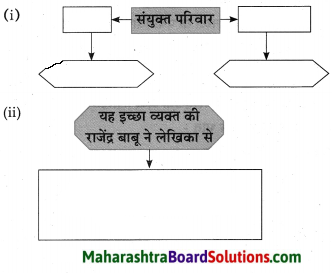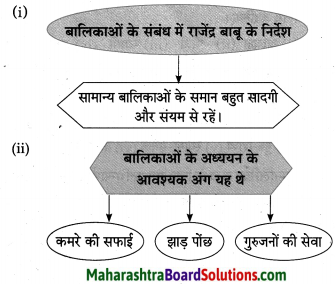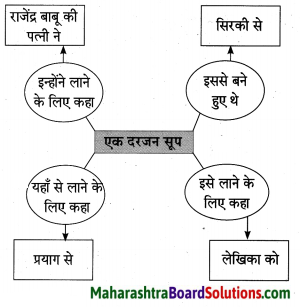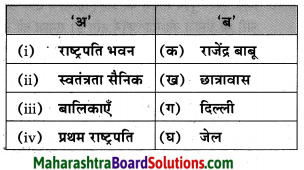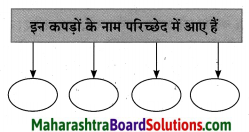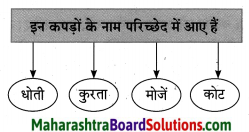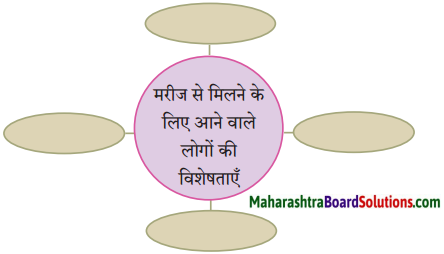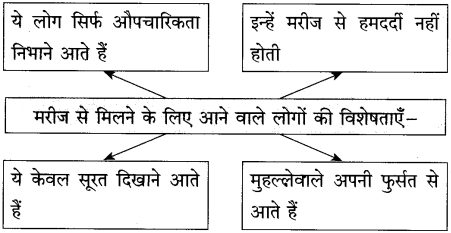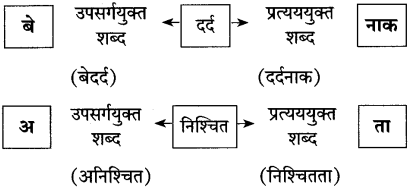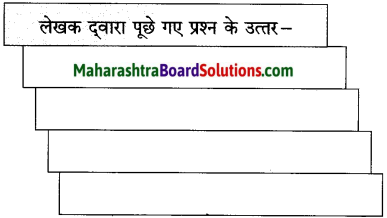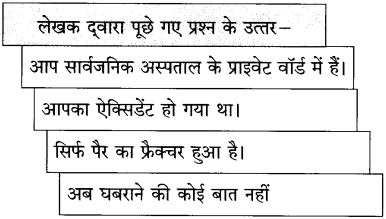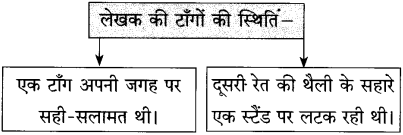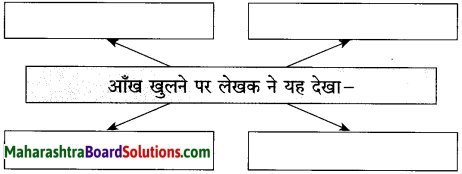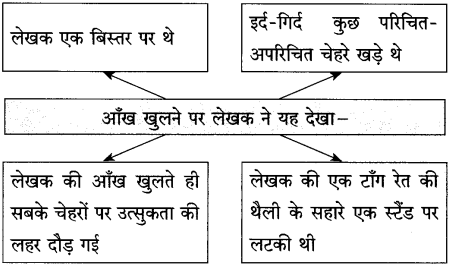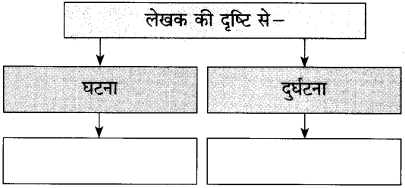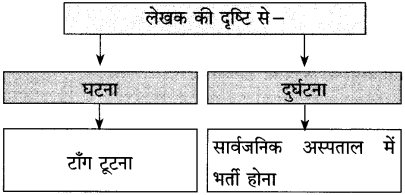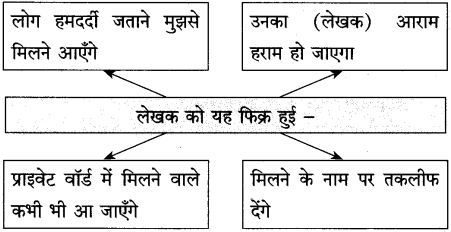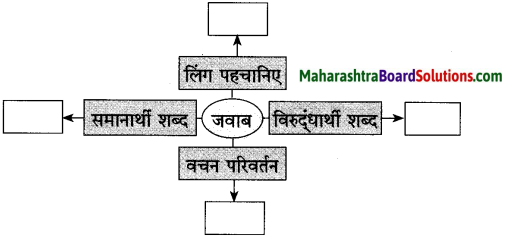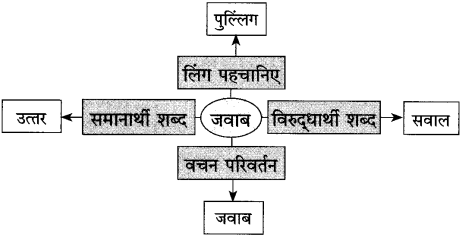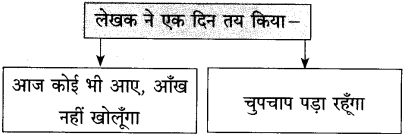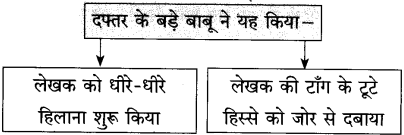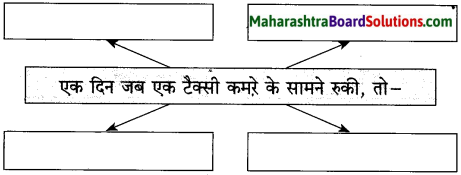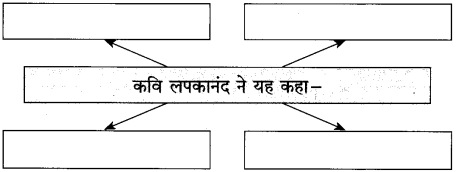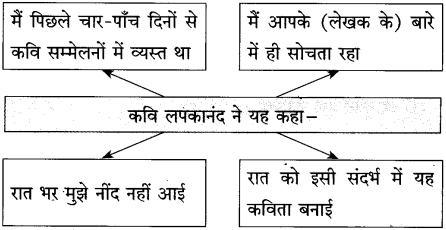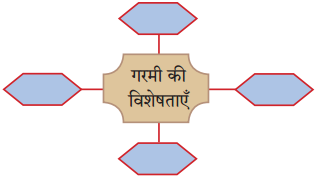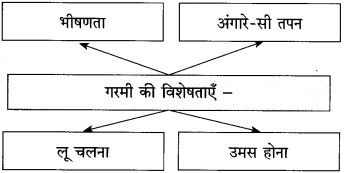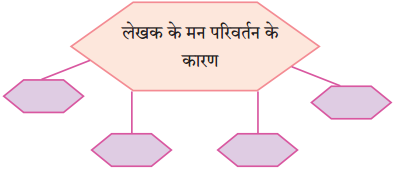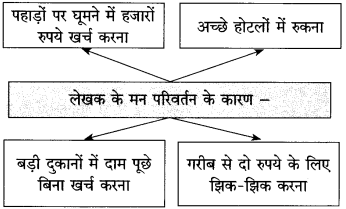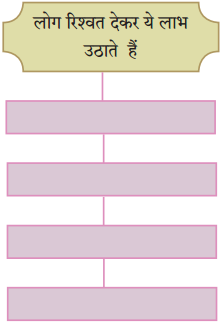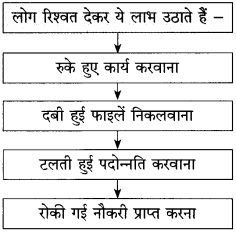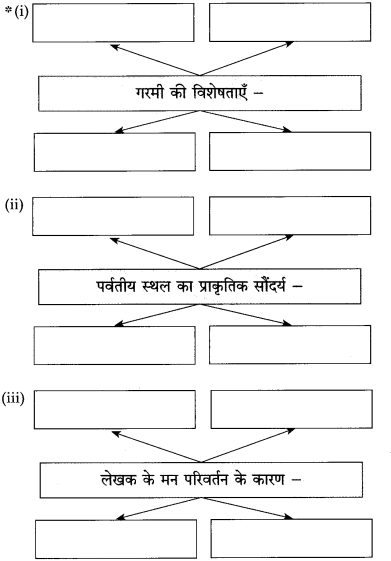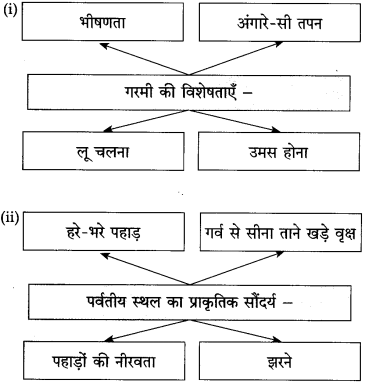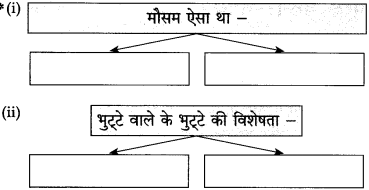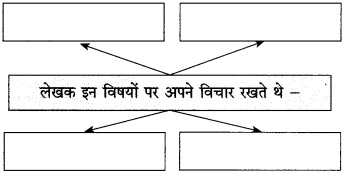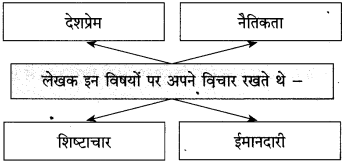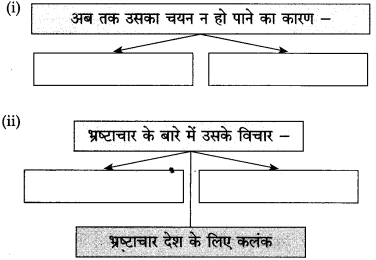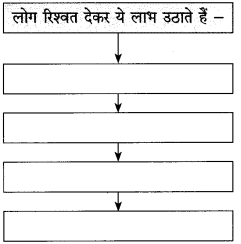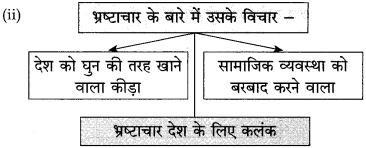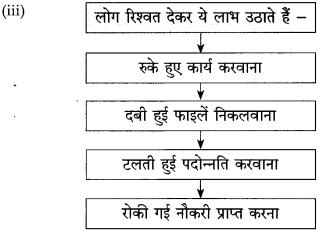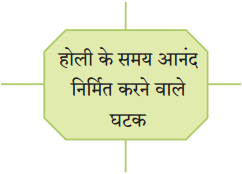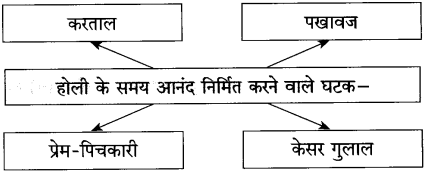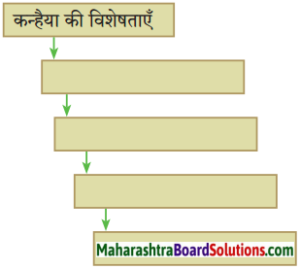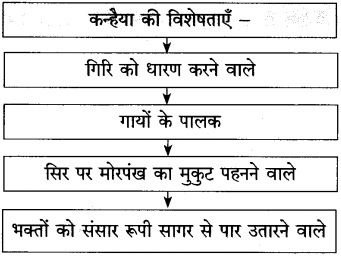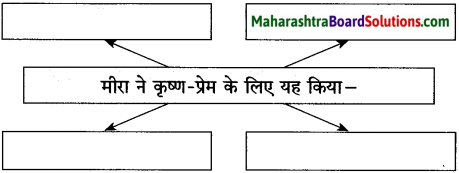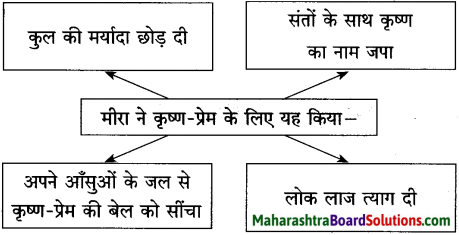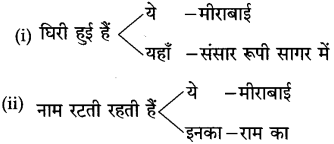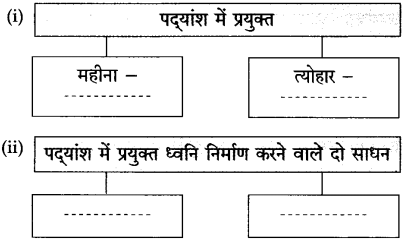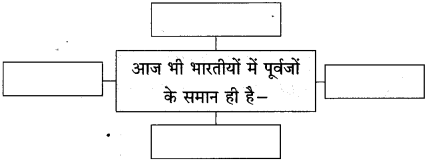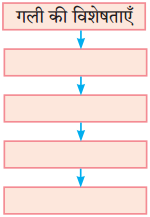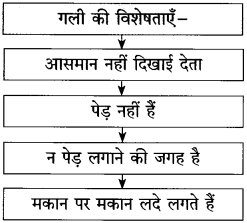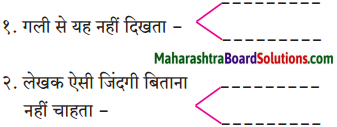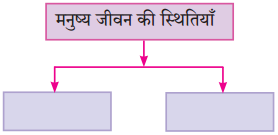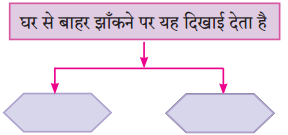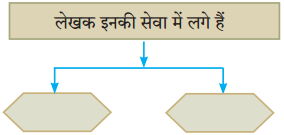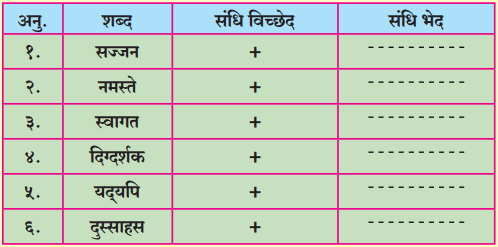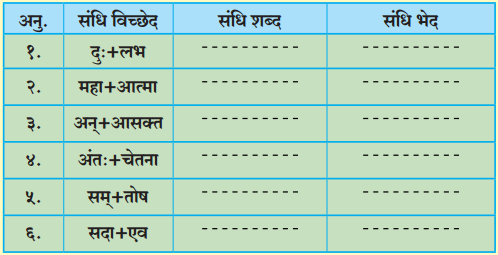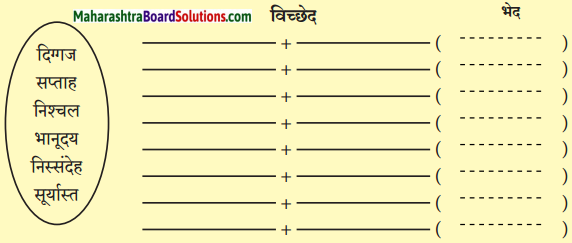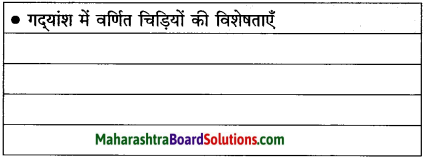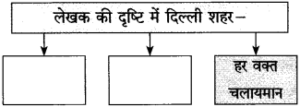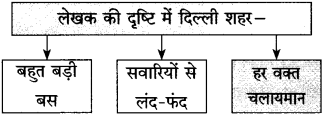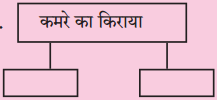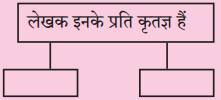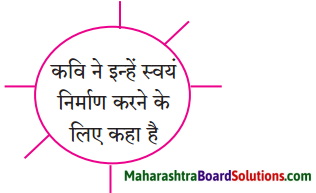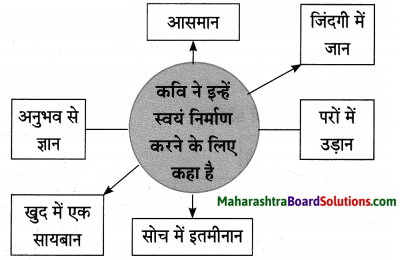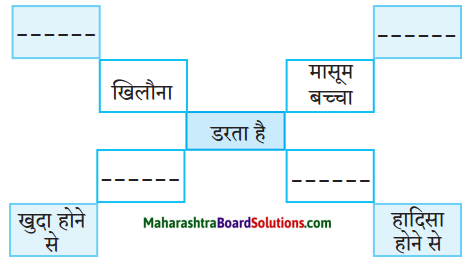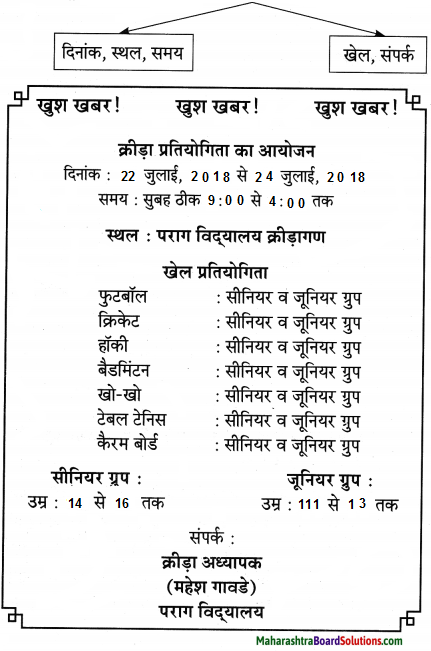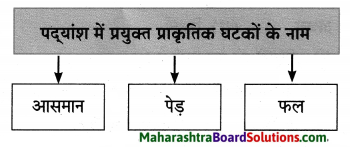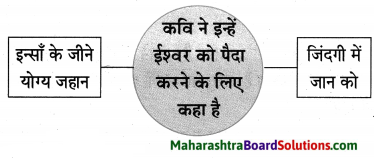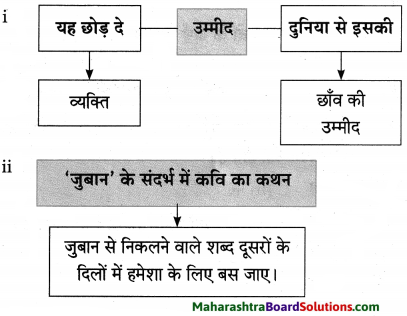Std 10 Hindi Chapter 7 Mahila Ashram Question Answer Maharashtra Board
Balbharti Maharashtra State Board Class 10 Hindi Solutions Chapter 7 महिला आश्रम Notes, Textbook Exercise Important Questions, and Answers.
Hindi Lokbharti 10th Digest Chapter 7 महिला आश्रम Questions And Answers
Hindi Lokbharti 10th Std Digest Chapter 7 महिला आश्रम Textbook Questions and Answers
कृति
कृतिपत्रिका के प्रश्न 1 (अ) तथा 1 (आ) के लिए
सूचना के अनुसार कृतियाँ कीजिए :
प्रश्न 1.
संजाल पूर्ण कीजिए:
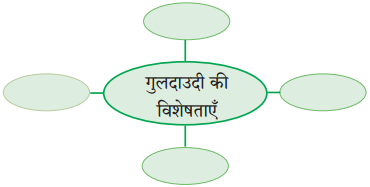
उत्तर:
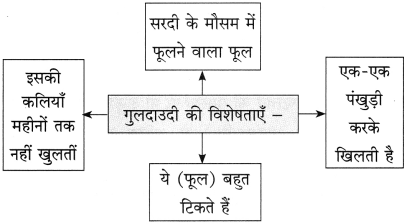
प्रश्न 2.
कारण लिखिए:
a. काका जी ने कंपास बॉक्स मँगाकर रखा –
b. लेखक ने फूल के गमले अपने पास से निकाल दिए –
उत्तर:
(i) काका जी को तारों के नक्शे बनाने थे, इसलिए उन्होंने कंपास बॉक्स मँगा कर रखा।
(ii) काका जी के पासवाले गमलों में लगे फूलों के पौधे सूख गए थे, इसलिए काका जी ने फूलों के गमले अपने पास से निकाल दिए।
प्रश्न 3.
लिखिए:
a. जिन्हें ‘ता’ प्रत्यय लगा हो ऐसे शब्द पाठ से ढूँढ़कर उन प्रत्ययसाधित शब्दों की सूची बनाइए।
| शब्द | ‘ता’ | प्रत्यय साधित |
| ………………………………… | ………………………………… | ………………………………… |
| ………………………………… | ………………………………… | ………………………………… |
उत्तर:
| 1. मानव | ता | मानवता |
| 2. कुशल | ता | कुशलता |
| 3. उत्कृष्ट | ता | उत्कृष्टता |
| 4. एक | ता | एकता |
![]()
b. पाठ में प्रयुक्त पर्यायवाची शब्द लिखकर उनका स्वतंत्र वाक्यों में प्रयोग कीजिए।
उत्तर:
(i) घर = मकान।
घर – वाक्य : मनुष्य को अपने ही घर में सुकून मिलता है।
मकान – वाक्य : महानगरों में रोटी और वस्त्र तो किसी तरह मिल भी जाता है, पर मकान की व्यवस्था बहुत जटिल होती है।
(ii) बोझ = भार।
बोझ – वाक्य : गरीब लोगों के लिए गृहस्थी के खर्च का बोझ उठाना आसान नहीं होता।
भार – वाक्य : जिम्मेदार व्यक्ति दिए गए कार्य का भार उठाने में प्रसन्नता महसूस करते हैं।
प्रश्न 4.
प्रवाह तालिका पूर्ण कीजिए :
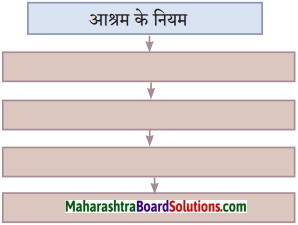
उत्तर:
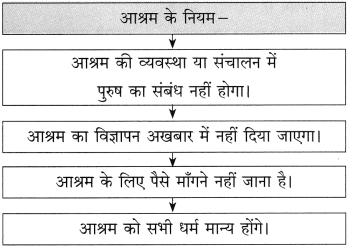
अभिव्यक्ति
पत्र लिखने का सिलसिला सदैव जारी रहना चाहिए’ इस संदर्भ में अपने विचार लिखिए।
उत्तर :
हर युग में पत्रों का बहुत महत्त्व हुआ करता था। प्राचीन काल में राजाओं-महाराजाओं के यहाँ विचारों के आदान-प्रदान के लिए पत्र-वहन की अपनी व्यवस्था थी। कबूतर जैसे पक्षी के माध्यम से भी पत्र भेजने का उल्लेख मिलता है। आम जनता के पत्र भेजने की सरकारी व्यवस्था थी। सरकारी हरकारे दूर-दराज के क्षेत्रों में पत्र पहुँचाने के लिए घोड़े और ऊँट आदि जानवरों का प्रयोग करते थे। आधुनिक काल में डाकघरों के माध्यम से पत्र भेजे जाते हैं। पर आजकल संचार माध्यम का बहुत तेजी से विकास होने के कारण संदेश भेजने के माध्यम में बहुत प्रगति हो रही है।
पत्रों के साथ ई-मेल से संदेश भेजने की प्रक्रिया खूब लोकप्रिय हुई। आजकल अपनी बात दूसरों तक पहुँचाने में मोबाइल फोन अच्छा काम कर रहा है। पत्र (संदेश) भेजने के माध्यमों में समय के अनुसार बदलाव भले आता गया हो, पर पत्र (संदेश) का महत्त्व हमेशा बना रहेगा। सरकारी कामकाज तथा व्यवसाय के क्षेत्र में लेन-देन की बात भले फोन पर हो जाए, पर जब तक पत्र के माध्यम से लिखित रूप में कुछ नहीं होता, तब तक बात आगे नहीं बढ़ती है। इस तरह पत्र लिखने का सिलसिला सदा जारी रहा है और भविष्य में भी यह सिलसिला जारी रहेगा।
![]()
उपयोजित लेखन
‘संदेश वहन के आधुनिक साधनों से लाभ-हानि’ विषय पर अस्सी से सौ शब्दों तक निबंध लिखिए।
उत्तर:
एक समय ऐसा था, जब संदेश वहन के साधन बहुत सीमित थे। संदेश वहन का सर्वसुलभ और लोकप्रिय साधन पत्र हुआ करता था। तार और टेलीफोन भी संदेश वहन के साधन थे। तार का संकटकाल के समय उपयोग किया जाता था और टेलीफोन सबके लिए उपलब्ध नहीं था। आज जमाना बदल गया है। आज संदेश वहन के एक-से-बढ़ कर एक साधन उपलब्ध हैं। आप देश के किसी भी कोने में बैठे हों, क्षण भर में मोबाइल फोन पर अपना मनचाहा नंबर डायल करके सामनेवाले से बात कर सकते हैं।
अपने मोबाइल फोन पर सामनेवाले को सामने-सामने बात करते हुए देख सकते हैं। वीडियो कांफ्रेसिंग में अलग-अलग जगहों पर बैठे लोगों से अपने घर में बैठकर सामने-सामने लोग बात कर लेते हैं। व्हाट्सअप पर अपने चित्र, डॉक्यूमेंट स्कैन करके क्षण भर में सामनेवाले तक पहुंचा सकते हैं। एस.एम.एस., फेसबुक, ट्विटर से मनचाहा संदेश भेजा जा सकता है।
ई-मेल से पत्र के रूप में लिखित समाचार भेज सकते हैं, जिसे प्रमाण के रूप में रखा जा सकता है।
संदेश वहन के आधुनिक साधनों के कारण जनता को जहाँ इस तरह की सुविधाएँ उपलब्ध है, वहीं लोगों को इनसे अनेक परेशानियाँ भी हो रही हैं। आप इन साधनों के कारण सबसे जुड़े हुए हैं। तरहतरह के लोग इसका फायदा उठाकर आपको अनावश्यक एस.एम.एस. के द्वारा तंग कर सकते हैं, आपको ठगने की कोशिश कर सकते हैं। एस.एम.एस. के द्वारा झूठी बातें और अफवाए भी फैलाई जा सकती हैं। मोबाइल फोन से अधिकतर लोग चिपके रहते हैं और अपना समय बर्बाद करते रहते हैं।
इस तरह आधुनिक संदेश वहन के साधनों से जहाँ अनेक प्रकार के लाभ हैं, वहीं उनसे कुछ नुकसान भी हैं। पर इससे चिंता करने की जरूरत नहीं है। आधुनिक संदेश वहन साधनों की कमियाँ भी धीरे-धीरे दूर हो जाएँगी, ऐसी उम्मीद हमें रखनी चाहिए।
![]()
भाषा बिंदु
निम्न शब्दों से बने दो मुहावरों के अर्थ लिखकर उनका स्वतंत्र वाक्यों में प्रयोग कीजिए:
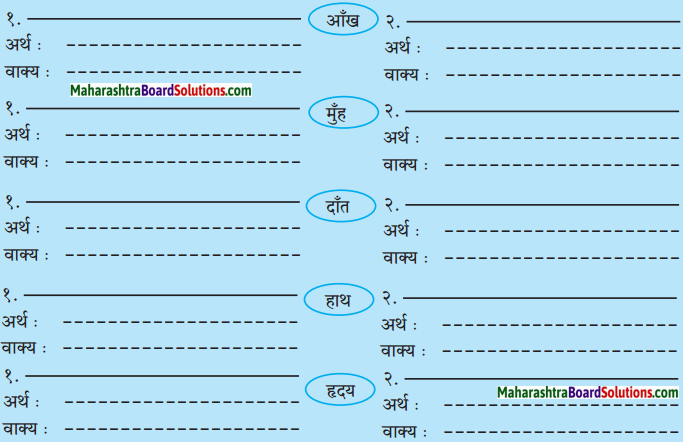
उत्तर:
(1) आँख :
(i) आँखों से ओझल होना।
अर्थ : अदृश्य हो जाना।
वाक्य : हवाई अड्डे से उड़ान भरने के बाद विमान देखते देखते आँखों से ओझल हो गया।
(ii) आँखें भर आना।
अर्थ : आँखों में आँसू आ जाना।
वाक्य : बेटी की बिदाई के समय पिता की आँखें भर आईं।
(2) मुँह :
(i) मुँह मोड़ लेना :
अर्थ : बेरुखी करना, ध्यान न देना।
वाक्य : सच्चाई से मुँह मोड़ लेने से सच बात झूठ नहीं “हो जाती।
(ii) मुँह की खाना।
अर्थ : बुरी तरह हारना।
वाक्य : करगिल युद्ध में पाकिस्तान को मुंह की खानी पड़ी।
(3) दाँत :
(i) दाँत पीसना।
अर्थ : क्रोध में दाँत पर दाँत रगड़ना।
वाक्य : बात-बात पर मुनीम जी की फटकार सुनकर चपरासी दाँत पीसने लगा।
![]()
(ii) दाँत काटी रोटी।
अर्थ : गहरी दोस्ती।
वाक्य : नेताजी और उस गुंडे में दाँत काटी रोटी थी।
(4) हाथ:
(i) हाथ का मैल होना।
अर्थ : बहुत तुच्छ वस्तु।
वाक्य : लाला रूपचंद के लिए छोटा-मोटा चंदा देना हाथ-का मैल है।
(ii) हाथ में आना।
अर्थ : काबू या कब्जे में आना।
वाक्य : काफी भाग-दौड़ के बाद अपराधी पुलिस के हाथ में आ गया।
(5) हृदय :
(i) हृदय उछलना।
अर्थ : बहुत प्रसन्नता होना।
वाक्य : छोटे-छोटे बच्चों की देशभक्ति देखकर हृदय आनंद से उछल पड़ता है।
(ii) हृदय पसीजना।
अर्थ : मन में करुणा, दया आदि भावों का संचार होना।
वाक्य : मोबाइल चोर पकड़े जाने पर लोगों से गिड़गिड़ता रहा कि वे उसे पुलिस को न दें, पर लोगों का हृदय नहीं पसीजा।
उपयोजित लेखन
अपने मित्र/सहेली को जिला विज्ञान प्रदर्शनी में प्रथम पुरस्कार प्राप्त होने के उपलक्ष्य में बधाई देते हुए निम्न प्रारूप में। पत्र लिखिए।
दिनांक : ………………………….
संबोधन : ………………………….
अभिवादन : ………………………….
प्रारंभ : ………………………….
विषय विवेचन: ………………………….
समापन : ………………………….
हस्ताक्षर : ………………………….
नाम : ………………………….
पता : ………………………….
ई-मेल आईडी : ………………………….
उत्तर :
15 नवंबर 2020
प्रिय नरेश,
खुश रहो।
आज ही तुम्हारा पत्र मिला। यह जानकर बहुत खुशी हुई कि जिला विज्ञान प्रदर्शनी में तुम्हें प्रथम पुरस्कार प्राप्त हुआ है। मेरी ओर से तुम्हें बहुत-बहुत बधाई।
जब मैंने तहसील स्तर पर आयोजित विज्ञान प्रदर्शनी में तुम्हारी कृति देखी थी, तभी मुझे विश्वास हो गया था कि तुम्हारी यह कृति एक दिन जिला स्तर की प्रदर्शनी में तुम्हें पुरस्कार अवश्य दिलाएगी। तुम्हारा प्रथम पुरस्कार पाना तुम्हारे शहर के लोगों के लिए गर्व की बात होगी। विज्ञान की कृतियों में तुम्हारी यह लगन एक-न-एक दिन तुम्हें प्रांत स्तर पर अवश्य सफलता दिलाएगी। हमारी शुभकामनाएँ सदा तुम्हारे साथ हैं।
तुम्हारा,
कमल
श्री. विजय पाठक
४५, कृष्णा विला,
महात्मा गांधी रोड,
औरंगाबाद, पिन कोड नं. 431 007
Kamal@abc.com
![]()
Hindi Lokbharti 10th Textbook Solutions Chapter 7 महिला आश्रम Additional Important Questions and Answers
गद्यांश क्र. 1
प्रश्न. निम्नलिखित पठित गद्यांश पढ़कर दी गई सूचनाओं के अनुसार कृतियाँ कीजिए :
कृति 1 : (आकलन)
प्रश्न 1.
संजाल पूर्ण कीजिए :
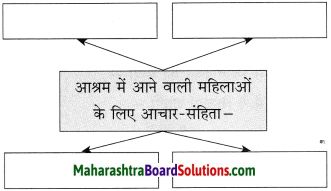
उत्तर:
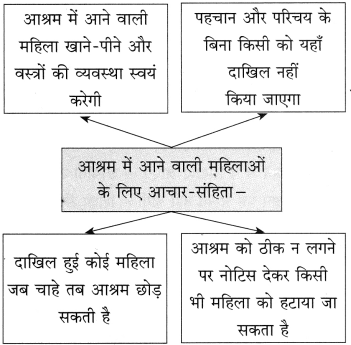
कृति 2 : (आकलन)
प्रश्न 1.
संजाल पूर्ण कीजिए :
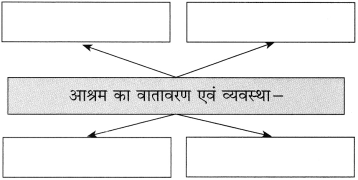
उत्तर:
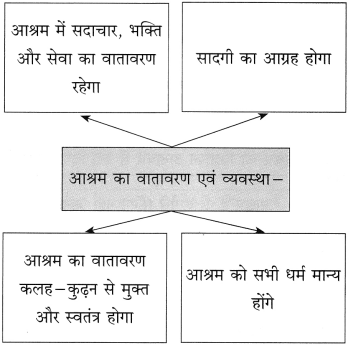
![]()
प्रश्न 2.
उत्तर लिखिए :
(i) गरीब स्त्री की सिफारिश कर आश्रम में दाखिल कराने वाली स्त्री का खर्च ये देंगे –
(ii) आश्रम में स्वावलंबन की मात्रा –
(iii) आश्रम में ये सिखाए जाएँगे –
(iv) आश्रम यह संस्था नहीं होगी –
उत्तर:
(i) गरीब स्त्री की सिफारिश कर आश्रम में दाखिल कराने वाली स्त्री का खर्च ये देंगे – सिफारिश करने वाले लोग।
(ii) आश्रम में स्वावलंबन की मात्रा – यथासंभव।
(iii) आश्रम में ये सिखाए जाएँगे – उपयोगी उद्योग।
(iv) आश्रम यह संस्था नहीं होगी – शिक्षा संस्था।
कृति 3 : (शब्द संपदा)
प्रश्न 1.
निम्नलिखित शब्दों के समानार्थी शब्द लिखिए :
(i) अखबार = ……………………..
(ii) व्यवस्था = ……………………..
(iii) बेखटक = ……………………..
(iv) बोझ = ……………………..
उत्तर:
(i) अखबार = समाचारपत्र
(ii) व्यवस्था = इंतजाम
(iii) बेखटक = अर्शक
(iv) बोझ = भार।
प्रश्न 2.
निम्नलिखित शब्दों के विलोम शब्द लिखिए :
(i) पुरुष x ………………………………
(ii) गरीब x ………………………………
(iii) स्वतंत्र x ………………………………
(iv) मान्य x ………………………………
उत्तर:
(i) पुरुष x स्त्री
(i) गरीब x अमीर
(iii) स्वतंत्र x परतंत्र
(iv) मान्य x अमान्य।
कृति 4 : (स्वमत अभिव्यक्ति)
प्रश्न.
आश्रमों की आवश्यकता’ विषय पर अपने विचार 25 से 30 शब्दों में लिखिए।
उत्तर:
हमारे देश में आश्रमों की कल्पना बहुत प्राचीन काल से चली आ रही है। राजा-महाराजा बूढ़े हो जाने पर राज-पाट छोड़कर वानप्रस्थ आश्रम अपना लेते थे और अपना शेष जीवन जंगलों में कुटी बनाकर सामान्य मनुष्य की तरह बिताया करते थे। पर आज वैसा समय नहीं रहा और राजा-महाराजा भी नहीं रहे। अब समाज में नई तरह की समस्याएँ खड़ी हुई हैं। संयुक्त परिवार टूट रहे हैं। पति-पत्नी में संबंधविच्छेद हो रहे हैं। इसका प्रभाव बच्चों पर पड़ रहा है। ऐसे में बच्चे घर से भागते हैं।
![]()
वृद्ध माता-पिता बेटे-बहू के लिए भार लगने लगते हैं। इन सब समस्याओं ने आधुनिक ढंग के आश्रमों को जन्म दिया है। इसके परिणामस्वरूप आज देश में वृद्धाश्रम, महिला आश्रम तथा बाल-आश्रम (बाल सुधारगृह) जैसे आश्रमों का निर्माण किया जा रहा है। इन आश्रमों में तिरस्कृत, उपेक्षित और परित्यक्त बच्चों, महिलाओं और वृद्धों को सहारा मिलता है। इन आश्रमों में इन्हें अपना सुरक्षित जीवन जीने का अवसर मिलता है। आश्रम आज के समय की आवश्यकता हैं।
गद्यांश क्र. 2
प्रश्न. निम्नलिखित पठित गद्यांश पढ़कर दी गई सूचनाओं के अनुसार कृतियाँ कीजिए :
कृति 1 : (आकलन)
आकृति पूर्ण कीजिए:

उत्तर:
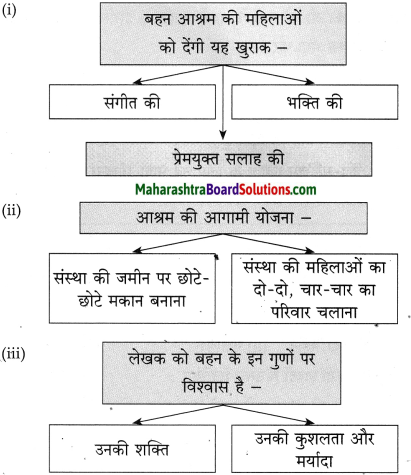

![]()
कृति 2 : (आकलन)
प्रश्न 1.
उत्तर लिखिए :

उत्तर:

कृति 3 : (शब्द संपदा)
प्रश्न 1.
निम्नलिखित शब्दों के वचन बदलकर लिखिए :
(i) बहनें – …………………………………
(ii) संस्था – …………………………………
(iii) मैं – …………………………………
(iv) पंखुड़ी – …………………………………
उत्तर:
(i) बहनें – बहन
(ii) संस्था – संस्थाएँ
(iii) मैं – हम
(iv) पंखुड़ी – पंखुड़ियाँ।
प्रश्न 2.
निम्नलिखित शब्दों के लिंग पहचानकर लिखिए :
(i) संगीत – …………………………………
(ii) समाज – …………………………………
(iii) कली – …………………………………
(iv) पंखुड़ी – …………………………………
उत्तर:
(i) संगीत – पुल्लिग
(ii) समाज – पुल्लिंग
(iii) कली – स्त्रीलिंग
(iv) पंखुड़ी – स्त्रीलिंग।
कृति 4 : (स्वमत अभिव्यक्ति)
प्रश्न.
‘आश्रमों की व्यवस्था’ के बारे में अपना विचार 25 से 30 शब्दों में लिखिए।
उत्तर:
हमारे देश में तरह-तरह के अनेक आश्रम हैं। इन आश्रमों का संचालन कुछ धर्मादा संस्थानों और सरकारी एजेंसियों द्वारा किया जाता है। इन आश्रमों की व्यवस्था संस्थानों अथवा सरकारी एजेंसियों द्वारा नियुक्त व्यक्तियों द्वारा की जाती है। कभी-कभी इन व्यक्तियों द्वारा अनुशासन अथवा अन्य किसी बात को लेकर आश्रमवासियों पर ज्यादती अथवा अत्याचार करने की खबरें भी आती रहती हैं।
![]()
अच्छा यह हो कि आश्रमों की व्यवस्था का काम आश्रमों में अपना जीवन बिताने वाले कुशल व्यक्तियों में से किसी व्यक्ति को सौंपा जाए अथवा बारी-बारी से निश्चित समय के लिए आश्रमवासियों में से कुशल व्यक्तियों को यह काम दिया जाए। इससे आश्रम में रहने वाले लोगों को व्यवस्था का कार्य सीखने का मौका मिलेगा और आश्रम में अत्याचार अथवा भ्रष्टाचार की समस्या पर भी अंकुश लगेगा। आश्रमों की समस्याओं से आश्रमवासियों से अधिक कौन परिचित हो सकता है? आश्रमवासियों के हाथ में आश्रम की व्यवस्था का काम देने से आश्रम की समस्याएँ आसानी से सुलझ सकती हैं।
गद्यांश क्र.3
प्रश्न. निम्नलिखित पठित गद्यांश पढ़कर दी गई सूचनाओं के अनुसार कृतियाँ कीजिए :
कृति 1 : (आकलन)
प्रश्न 1.
आकृति पूर्ण कीजिए :
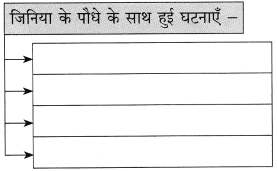
उत्तर:
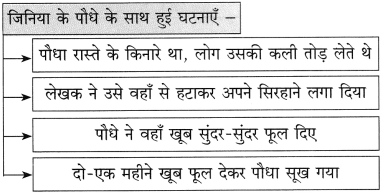
प्रश्न 2.
उत्तर लिखिए :
(i) पूज्य बापू जी क्या चाहते हैं?
(ii) परिच्छेद में आए दो धर्मों के नाम।
उत्तर:
(i) हिंदू-मुस्लिम एकता के लिए उर्दू भाषा सीखना आवश्यक है।
(ii) (अ) हिंदू
(ब) मुस्लिम।
कृति 2 : (आकलन)
प्रश्न 1.
दो ऐसे प्रश्न बनाकर लिखिए, जिनके उत्तर निम्नलिखित शब्द हों :
(i) एक-दो महीने
(ii) गुलाब।
उत्तर:
(i) जिनिया का पौधा कितने दिन फूल देने के बाद सूख गया?
(ii) अब कौन-सा फूल खिलने लगा है?
![]()
प्रश्न 2.
एक/दो शब्दों में उत्तर लिखिए :
(i) काका जी द्वारा सरोज को भेजा हुआ संदेश ………..
(ii) तबीयत से कमजोर
(iii) तारों के नक्शे बनाने के लिए उपयोगी ………..
(iv) काका जी ने इन्हें अपने पास से निकाल दिया
उत्तर:
(i) उर्दू लिखना सीखो
(ii) सरोज
(iii) कंपास बॉक्स
(iv) फूल के गमले।
प्रश्न 3.
संजाल पूर्ण कीजिए : (बोर्ड की नमूना कृतिपत्रिका)
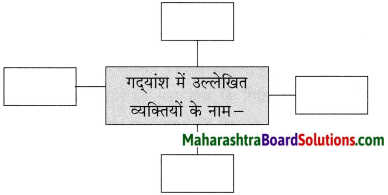
उत्तर:

प्रश्न 4.
उत्तर लिखिए :
(i) काका जी ने सरोज को इन तारीखों में पत्र लिखे – ……….
(ii) सरोज की तबीयत कमजोर होने तक काका जी को ये पत्र लिखेंगी – ………….
(iii) काका जी को सरोज का पत्र इस दिन मिला था –
(iv) इस फूल की आँखें उत्कटता से बोलती लगती थीं –
उत्तर:
(i) काका जी ने सरोज को इन तारीखों में पत्र लिखे – 1,9,15, 21.
(ii) सरोज की तबीयत कमजोर होने तक काका जी को ये पत्र लिखेंगी – चिरंजीव रैहाना।
(iii) काका जी को सरोज का पत्र इस दिन मिला था – गुरुवार, 21 दिसंबर 1944.
(iv) इस फूल की आँखें उत्कटता से बोलती लगती थीं – जिनिया।
![]()
प्रश्न 5.
निम्नलिखित कथन पढ़कर सत्य अथवा असत्य पहचानकर लिखिए : (बोर्ड की नमूना कृतिपत्रिका)
(i) पत्र रैहाना को लिखा गया है –
(ii) सरोज की तबीयत कमजोर है –
(iii) काका साहब ने अपने फूल के गमले अपने पास से निकाल दिए हैं –
(iv) काका साहब ने सरोज को पत्र लिखा है –
उत्तर:
(i) असत्य
(ii) सत्य
(iii) सत्य
(iv) सत्य।
कृति 3 : (शब्द संपदा)
प्रश्न 1.
उपसर्ग जोड़कर नए शब्द बनाइए :
(i) गति
(i) शासन
(ii) जय
(iv) दिन।
उत्तर:
(i) प्र + गति = प्रगति
(i) अनु + शासन = अनुशासन
(iii) परा + जय = पराजय
(iv) दुर् + दिन = दुर्दिन।
प्रश्न 2.
निम्नलिखित शब्दों में प्रत्यय लगाकर नए शब्द बनाइए :
(i) नौकर
(ii) चतुर
(iii) सुंदर
(iv) महान।
उत्तर:
(i) नौकर + ई = नौकरी
(ii) चतुर + आई = चतुराई
(iii) सुंदर + ता = सुंदरता
(iv) महान + ता = महानता।
![]()
प्रश्न 3.
गद्यांश में प्रयुक्त दो विदेशी शब्द ढूँढकर लिखिए।
(i) ………………………………
(ii) ………………………………
उत्तर:
(i) क्रोटन
(ii) तारीख
प्रश्न 4.
शब्द-समूह के लिए एक शब्द लिखिए : (बोर्ड की नमूना कृतिपत्रिका)
(i) सात दिनों का समूह ………………………………
(ii) 28, 29, 30, 31 दिनों का समूह ………………………………
उत्तर:
(i) सात दिनों का समूह-सप्ताह।
(ii) 28, 29, 30, 31 दिनों का समूह-महीना। 3
प्रश्न 5.
निम्नलिखित शब्दों के पर्यायवाची शब्द लिखिए : (बोर्ड की नमूना कृतिपत्रिका)
(1) पत्र = ………………………………
(ii) तारीख = ………………………………
उत्तर:
(i) पत्र = चिट्ठी, खत।
(ii) तारीख = दिनांक, तिथि।
कृति 4 : (स्वमत अभिव्यक्ति)
प्रश्न 1.
अपनी भावनाएँ प्रभावी ढंग से पहुँचने का सशक्त माध्यम पत्र हैं’ इस विषय पर अपने विचार 25 से 30 शब्दों में लिखिए। (बोर्ड की नमूना कृतिपत्रिका)
उत्तर:
मनुष्य अपनी भावनाओं को विभिन्न माध्यमों के द्वारा दूसरों तक पहुँचाता है। पत्र मनुष्य की भावनाओं को लिखित रूप में 3 किसी व्यक्ति तक पहुँचाने का सशक्त माध्यम है। हालाँकि टेलीफोन और मोबाइल फोन लोगों की भावनाओं को शीघ्र दूसरों तक पहुँचाने के साधन बन गए हैं। पर पत्रों की उपयोगिता आज भी पहले जैसी ही बरकरार है। इन्हें लोग बार-बार पढ़ते और सँजोकर भी रखते हैं। पत्र बहुत कीमती होते हैं। समय बीत जाने पर कुछ पत्र इतिहास की घटनाएँ बन जाते हैं। जिन्हें अन्य लोग भी पढ़ना चाहते हैं। जवाहरलाल नेहरू ३ द्वारा अपनी पुत्री इंदिरा को लिखे हुए पत्र ‘पिता के पत्र पुत्री के नाम’ ३ से प्रसिद्ध हैं। इसी तरह अमेरिका के राष्ट्रपति अब्राहम लिंकन द्वारा अपने बेटे के शिक्षक को लिखा गया एक पत्र भी बहुत प्रसिद्ध है। इस १ तरह पत्र के माध्यम से अपनी भावनाओं को प्रभावी ढंग से एक-दूसरे 3 तक पहुँचाने के उपर्युक्त पत्र जीते-जागते प्रमाण हैं।
भाषा अध्ययन (व्याकरण)
प्रश्न. सूचनाओं के अनुसार कृतियाँ कीजिए :
1. शब्द भेद :
अधोरेखांकित शब्दों के शब्दभेद पहचानकर लिखिए :
(i) आगे चलकर संस्था की जमीन पर छोटे-छोटे मकान बनेंगे।
(ii) अब चिरंजीव रैहाना मुझे पत्र लिखेंगी।
उत्तर :
(i) छोटे-छोटे – गुणवाचक विशेषण।
(ii) रैहाना – व्यक्तिवाचक संज्ञा।
![]()
2. अव्यय:
निम्नलिखित अव्ययों का अपने वाक्यों में प्रयोग कीजिए :
(i) यहाँ
(ii) कहीं।
उत्तर:
(i) इतना विश्वास न होता तो मैं यहाँ सूचित ही न करता।
(ii) आश्रम के लिए कहीं पैसे माँगने नहीं जाना है।
3. संधि :
कृति पूर्ण कीजिए :
| संधि शब्द | संधि विच्छेद | संधि भेद |
| उल्लेख | …………………………… | …………………………… |
| अथवा | ||
| …………………………… | अति + अधिक | …………………………… |
उत्तर:
| संधि शब्द | संधि विच्छेद | संधि भेद |
| उल्लेख | उत् + लेख | व्यंजन संधि |
| अथवा | ||
| अत्यधिक | अति + अधिक | स्वर संधि |
4. सहायक क्रिया:
निम्नलिखित वाक्यों में से सहायक क्रियाएँ पहचानकर उनका मूल रूप लिखिए :
(i) तुम पूरा आराम लेकर पूरी तरह ठीक हो जाओ।
(ii) ऐसा कदम सोचकर लेना होगा।
उत्तर :
सहायक क्रिया – मूलरूप
(i) जाओ – जाना
(ii) होगा – होना।
![]()
5. प्रेरणार्थक क्रिया :
निम्नलिखित क्रियाओं के प्रथम प्रेरणार्थक और द्वितीय प्रेरणार्थक रूप लिखिए :
(i) लिखना
(ii) मिलना।
उत्तर:
क्रिया – प्रथम प्रेरणार्थक रूप – द्वितीय प्रेरणार्थक रूप
(i) लिखना – लिखाना – लिखवाना
(ii) मिलना – मिलाना – मिलवाना
6. मुहावरे :
प्रश्न 1.
निम्नलिखित मुहावरों का अर्थ लिखकर वाक्य में प्रयोग कीजिए :
(i) सन्न रह जाना
(ii) भार वहन करना।
उत्तर :
(i) सन्न रह जाना।
अर्थ : भौचक रह जाना।
वाक्य : नरेश की लांछन लगाने वाली बातें सुनकर मोहन सन्न रह गया।
(i) भार वहन करना।
अर्थ : किसी चीज का भार उठाना।
वाक्य : जनता को सरकारी कर का भार वहन करना ही पड़ता है।
प्रश्न 2.
अधोरेखांकित वाक्यांशों के लिए कोष्ठक में दिए गए उचित मुहावरे का चयन करके वाक्य फिर से लिखिए : (पर्दाफाश करना, खानापूर्ति करना, सिर माथे लेना)
(i) चोर के एक साथी ने पुलिस अधिकारी के सामने मोटर साइकिल चुराने वाले दल का भेद खोल दिया।
(ii) मुंशी जी सेठ जी का आदेश सदा आदर सहित मानते हैं।
उत्तर :
(i) चोर के एक साथी ने पुलिस अधिकारी के सामने मोटर साइकिल चुराने वाले दल का पर्दाफाश कर दिया।
(ii) मुंशी जी सेठ जी का आदेश सदा सिर माथे लेते हैं।
7. कारक:
निम्नलिखित वाक्यों में प्रयुक्त कारक पहचानकर उसका भेद लिखिए :
(i) बहन महिलाओं को संगीत की शिक्षा दें।
(ii) आश्रम का विज्ञापन अखबार में नहीं दिया जाए।
उत्तर :
(i) महिलाओं को – कर्म कारक।
(ii) अखबार में – अधिकरण कारक।
8. विरामचिह्न :
निम्नलिखित वाक्यों में यथास्थान उचित विरामचिह्नों का प्रयोग करके वाक्य फिर से लिखिए :
(i) संस्था की जमीन पर छोटे छोटे मकान बनाए जाएँगे
(ii) फूलों में गुलदाउदी क्रिजेन्थीमम फूल बहार में हैं
उत्तर :
(i) संस्था की जमीन पर छोटे-छोटे मकान बनाए जाएंगे।
(ii) फूलों में गुलदाउदी, क्रिजेन्थीमम फूल बहार में हैं
![]()
9. काल परिवर्तन :
निम्नलिखित वाक्यों का सूचना के अनुसार काल परिवर्तन कीजिए :
(i) आश्रम शिक्षा संस्था नहीं होगी। (सामान्य वर्तमानकाल)
(ii) संस्था अपने आप चलेगी। (अपूर्ण वर्तमानकाल)
उत्तर :
(i) आश्रम शिक्षा संस्था नहीं होती है।
(ii) संस्था अपने आप चल रही है।
10. वाक्य भेद :
प्रश्न 1.
निम्नलिखित वाक्यों का रचना के आधार पर भेद पहचानकर लिखिए :
(i) आश्रम किसी एक धर्म से चिपका नहीं होगा।
(ii) यहाँ परेशान महिलाएं बेखटके अपने खर्च से रह सकें और अपने जीवन का सदुपयोग पवित्र सेवा में कर सकें।
(iii) वह यदि गरीब है, तो उसकी सिफारिश करने वाले लोगों को खर्च की पक्की व्यवस्था करनी चाहिए।
उत्तर :
(i) सरल वाक्य
(ii) संयुक्त वाक्य
(iii) मिश्र वाक्य।
प्रश्न 2.
निम्नलिखित वाक्यों का अर्थ के आधार पर दी गई सूचना के अनुसार वाक्य परिवर्तन कीजिए :
(i) तुम्हें अपना खयाल रखना चाहिए। (आज्ञावाचक वाक्य)
(ii) यहाँ सरदी अच्छी है। (प्रश्नवाचक वाक्य)
उत्तर :
(i) तुम अपना खयाल रखो!
(ii) क्या यहाँ सरदी अच्छी है?
11. वाक्य शुद्धिकरण :
निम्नलिखित वाक्य शुद्ध करके फिर से लिखिए :
(i) उनके ऊपर अइसा बोज नहीं आएगा, जिससे कि उन्हें परेशानी हो।
(ii) सभी धरम आश्रम को मान होंगे।
उत्तर :
(i) उनके ऊपर ऐसा बोझ नहीं आएगा, जिससे कि उन्हें परेशानी हो।
(ii) सभी धर्म आश्रम को मान्य होंगे।
उपक्रम/कृति/परियोजना
श्रवणीय
मानवतावाद पर विचार सुनिए।
पठनीय
अंतरिक्ष विज्ञान में ख्याति प्राप्त दो महिलाओं की जानकारी पदिए।
संभाषणीय
‘अनुशासन स्वयं विकास का प्रथम चरण है’, कथन पर चर्चा कीजिए।
उपयोजित लेखन
प्रश्न 1.
लेखनीय : किसी सामाजिक संस्था की जानकारी लिखिए।
उत्तर :
स्वयंसेवी संस्था ‘मासूम’ रात्रिकालीन पाठशालाओं में विद्यार्थियों तथा अध्यापकों की हर प्रकार की मदद देने के प्रति समर्पित एक स्वयंसेवी संस्था है-‘मासूम’। इस संस्था की स्थापना की है निकिता केतकर ने।
![]()
यह संस्था रात्रिकालीन पाठशालाओं में पढ़ने वाले सभी विद्यार्थियों को प्रतिदिन नाश्ता प्रदान करने के साथ-साथ उन्हें मुफ्त पाठ्यपुस्तकें, सहायक पुस्तकें, कापियाँ, कंपास बॉक्स तथा अन्य सामग्री प्रदान करती है। इसके अलावा मोबाइल-प्रयोगशाला तथा प्रयोग करने की विभिन्न सामग्री भी मुहैया कराती है। संस्था रात्रिकालीन पाठशालाओं के विद्यार्थियों को आगे की पढ़ाई के लिए स्कॉलरशिप देती है।
विद्यार्थियों की सुविधा के लिए यह संस्था स्पेशल क्लास और कैरिअर गाइडेन्स की व्यवस्था करती है। इसके अलावा यह रात्रिकालीन पाठशालाओं के मुख्याध्यापकों तथा शिक्षकों की ट्रेनिंग की भी व्यवस्था करती है। मुंबई की 70 रात्रिकालीन पाठशालाओं को ये सारी सुविधाएँ मुफ्त प्रदान की जाती हैं।
महिला आश्रम Summary in Hindi
विषय-प्रवेश : प्रसिद्ध गांधीवादी काका कालेलकर की गणना उच्च कोटि के निबंधकारों में की जाती है। प्रस्तुत रचना पत्र के रूप में लिखी गई है। प्रस्तुत पत्रों में लेखक ने आदर्श महिला आश्रम की स्थापना, उसकी व्यवस्था, उसके नियम तथा अनुशासन आदि के बारे में विस्तार से लिखा है।
Hindi Lokbharti 10th Textbook Solutions दूसरी इकाई
- बरषहिं जलद Question Answer
- दो लघुकथाएँ Question Answer (पूरक पठन)
- श्रम साधना Question Answer
- छापा Question Answer
- ईमानदारी की प्रतिमूर्ति Question Answer
- हम उस धरती की संतति हैं Question Answer (पूरक पठन)
- महिला आश्रम Question Answer
- अपनी गंध नहीं बेचूँगा Question Answer
- जब तक जिंदा रहूँ, लिखता रहूँ Question Answer
- बूढ़ी काकी Question Answer (पूरक पऊन)
- समता की ओर Question Answer
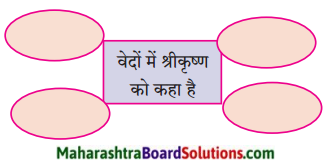

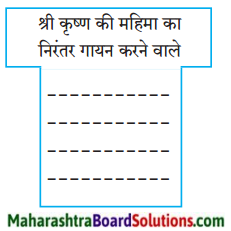
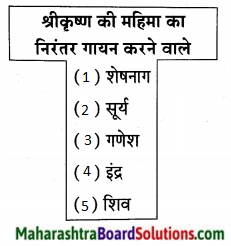
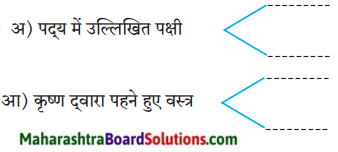
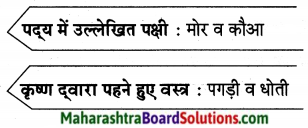

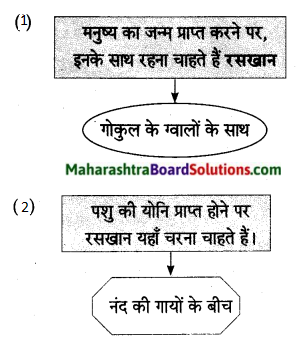
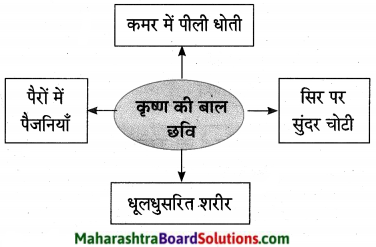
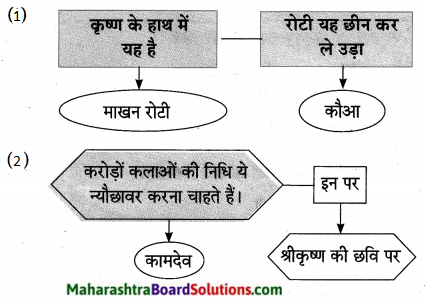
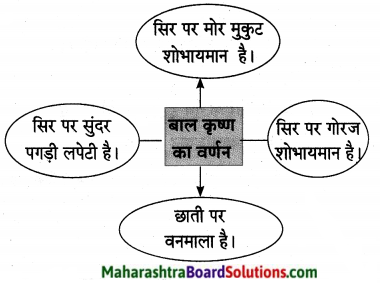
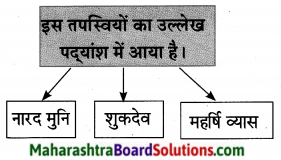
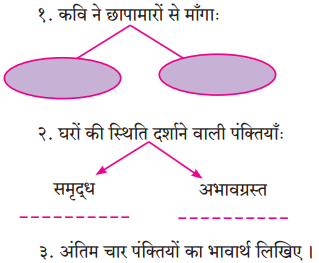 उत्तर:
उत्तर:  (ii)
(ii) 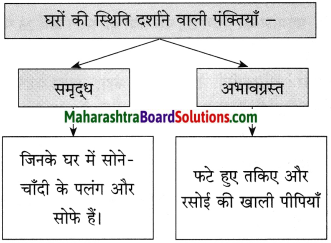 प्रश्न 2. संजाल पूर्ण कीजिए:
प्रश्न 2. संजाल पूर्ण कीजिए: 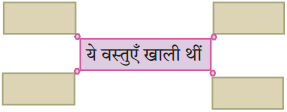 उत्तर:
उत्तर: 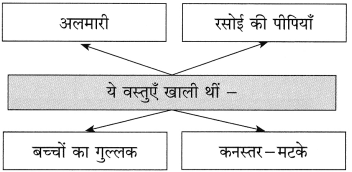 प्रश्न 2. कृति पूर्ण कीजिए:
प्रश्न 2. कृति पूर्ण कीजिए:  उत्तर:
उत्तर: 
 प्रश्न 3. कविता के आधार पर जोड़ियाँ मिलाइए: अ – आ अर्थ – बालों में सुवर्ण – चेहरे पर चाँदी – नई कविता में मुद्रा – काव्य कृतियों में उत्तर: (i) अर्थ – नई कविता में (ii) सुवर्ण – काव्य कृतियों में (iii) चाँदी – बालों में (iv) मुद्रा – चेहरे पर। प्रश्न 4. प्रवाह तालिका पूर्ण कीजिए:
प्रश्न 3. कविता के आधार पर जोड़ियाँ मिलाइए: अ – आ अर्थ – बालों में सुवर्ण – चेहरे पर चाँदी – नई कविता में मुद्रा – काव्य कृतियों में उत्तर: (i) अर्थ – नई कविता में (ii) सुवर्ण – काव्य कृतियों में (iii) चाँदी – बालों में (iv) मुद्रा – चेहरे पर। प्रश्न 4. प्रवाह तालिका पूर्ण कीजिए: 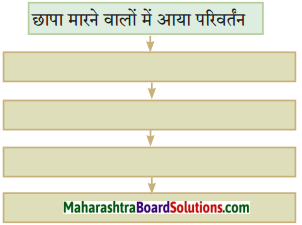 उत्तर:
उत्तर: 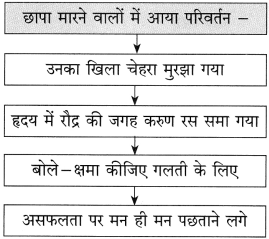 प्रश्न 5. ऐसे प्रश्न बनाइए जिनके उत्तर निम्न शब्द हों a. अरण्यकांड b. तख्त c. असफलता d. अनधिकृत उत्तर: a. कवि के घर में क्या देखकर छापा मारने वालों का खिला चेहरा मुरझा गया? b. कवि छापा मारने वालों से अपने घर में क्या डलवाने के लिए कहते हैं? c. कवि के घर छापा मारने पर छापा मारने वालों को क्या मिली? d. छापा मारने वालों को लेखक से किस प्रकार का अर्थ चाहिए था? प्रश्न 6. सोना, चाँदी, अर्थ और मुद्रा इन शब्दों के विभिन्न अर्थ बताते हुए कविता के आधार पर इनके अर्थ लिखिए। उत्तर:
प्रश्न 5. ऐसे प्रश्न बनाइए जिनके उत्तर निम्न शब्द हों a. अरण्यकांड b. तख्त c. असफलता d. अनधिकृत उत्तर: a. कवि के घर में क्या देखकर छापा मारने वालों का खिला चेहरा मुरझा गया? b. कवि छापा मारने वालों से अपने घर में क्या डलवाने के लिए कहते हैं? c. कवि के घर छापा मारने पर छापा मारने वालों को क्या मिली? d. छापा मारने वालों को लेखक से किस प्रकार का अर्थ चाहिए था? प्रश्न 6. सोना, चाँदी, अर्थ और मुद्रा इन शब्दों के विभिन्न अर्थ बताते हुए कविता के आधार पर इनके अर्थ लिखिए। उत्तर:  प्रश्न 7. कर जमा करना, देश के विकास को गति देना हैं’ विषय पर अपने विचार लिखिए। उत्तर: समाज में दो तरह के लोग होते हैं। एक वे, जो कर अदा करने लायक आय होने पर स्वेच्छा से ईमानदारी के साथ सरकार को कर अदा | कर देते हैं और दूसरे वे, जो कमाई तो जायज-नाजायज अंधाधुंध करते हैं, पर नियम के तहत कर अदा करने से कतराते हैं। यह मनोवृत्ति उचित नहीं है। देश के विकास का कार्य जनता द्वारा प्राप्त कर से ही पूरा होता है। चिकित्सा, परिवहन तथा जनता की सहायतार्थ शुरू किए जाने वाले सारे कार्य जनता से प्राप्त कर से ही पूरे होते हैं। जिस देश में आय करने वाले सभी लोग ईमानदारी और स्वेच्छा से उचित मात्रा में कर अदा करते हैं, उस देश के विकास के सारे कार्य सुचारू रूप से पूरे होते हैं और सामान्य जनता को उसका पूरा-पूरा लाभ मिलता है। यदि कोई व्यक्ति यह सोचता हो कि सभी लोग तो कर अदा करते हैं, उसके अकेले कर अदा न करने या कम कर का भुगतान करने से क्या फर्क पड़ेगा, ‘तो ऐसा सोचने वालों की संख्या अनगिनत हो सकती है। इस तरह कर की कितनी रकम सरकारी खजाने में जमा होने से रह जाती है। इस कारण पैसे के अभाव में सरकार की अनेक योजनाएँ अटकी रह जाती हैं। इसलिए कर योग्य आय पर ईमानदारी से कर जमा करना प्रत्येक नागरिक का कर्तव्य है। कर अदा कर हम अपनी ही सहायता करते हैं। कर जमा करने से ही विकास को गति मिलती है।
प्रश्न 7. कर जमा करना, देश के विकास को गति देना हैं’ विषय पर अपने विचार लिखिए। उत्तर: समाज में दो तरह के लोग होते हैं। एक वे, जो कर अदा करने लायक आय होने पर स्वेच्छा से ईमानदारी के साथ सरकार को कर अदा | कर देते हैं और दूसरे वे, जो कमाई तो जायज-नाजायज अंधाधुंध करते हैं, पर नियम के तहत कर अदा करने से कतराते हैं। यह मनोवृत्ति उचित नहीं है। देश के विकास का कार्य जनता द्वारा प्राप्त कर से ही पूरा होता है। चिकित्सा, परिवहन तथा जनता की सहायतार्थ शुरू किए जाने वाले सारे कार्य जनता से प्राप्त कर से ही पूरे होते हैं। जिस देश में आय करने वाले सभी लोग ईमानदारी और स्वेच्छा से उचित मात्रा में कर अदा करते हैं, उस देश के विकास के सारे कार्य सुचारू रूप से पूरे होते हैं और सामान्य जनता को उसका पूरा-पूरा लाभ मिलता है। यदि कोई व्यक्ति यह सोचता हो कि सभी लोग तो कर अदा करते हैं, उसके अकेले कर अदा न करने या कम कर का भुगतान करने से क्या फर्क पड़ेगा, ‘तो ऐसा सोचने वालों की संख्या अनगिनत हो सकती है। इस तरह कर की कितनी रकम सरकारी खजाने में जमा होने से रह जाती है। इस कारण पैसे के अभाव में सरकार की अनेक योजनाएँ अटकी रह जाती हैं। इसलिए कर योग्य आय पर ईमानदारी से कर जमा करना प्रत्येक नागरिक का कर्तव्य है। कर अदा कर हम अपनी ही सहायता करते हैं। कर जमा करने से ही विकास को गति मिलती है। 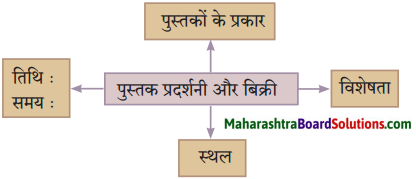 उत्तर:
उत्तर: 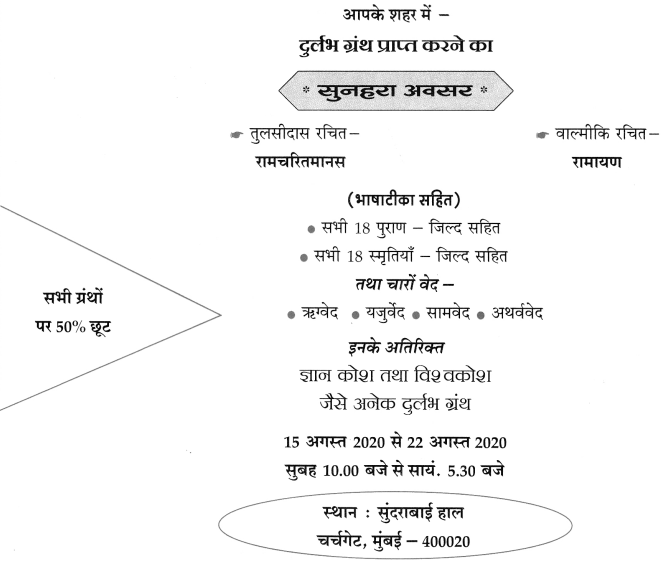 Hindi Lokbharti 10th Textbook Solutions Chapter 4 छापा Additional Important Questions and Answers
Hindi Lokbharti 10th Textbook Solutions Chapter 4 छापा Additional Important Questions and Answers 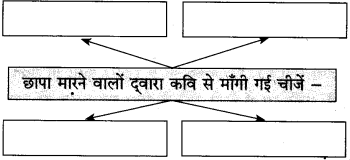 उत्तर:
उत्तर:  प्रश्न 2. निम्नलिखित प्रश्नों के उत्तर लिखिए: (i) वे (छापा मारने वाले) रोष से बोले तो कवि किस प्रकार बोले? (ii) वे (छापा मारने वाले) कड़ककर बोले तो कवि किस प्रकार बोले? उत्तर: (i) वे रोष से बोले तो कवि जोश से बोले। (ii) वे कड़ककर बोले तो कवि भड़ककर बोले। प्रश्न 3. संजाल पूर्ण कीजिए:
प्रश्न 2. निम्नलिखित प्रश्नों के उत्तर लिखिए: (i) वे (छापा मारने वाले) रोष से बोले तो कवि किस प्रकार बोले? (ii) वे (छापा मारने वाले) कड़ककर बोले तो कवि किस प्रकार बोले? उत्तर: (i) वे रोष से बोले तो कवि जोश से बोले। (ii) वे कड़ककर बोले तो कवि भड़ककर बोले। प्रश्न 3. संजाल पूर्ण कीजिए: 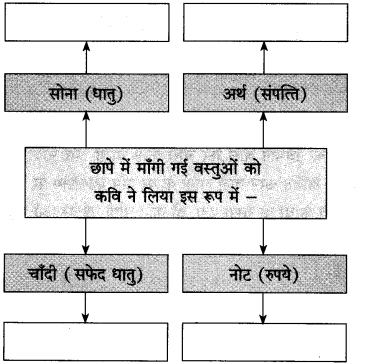 उत्तर:
उत्तर: 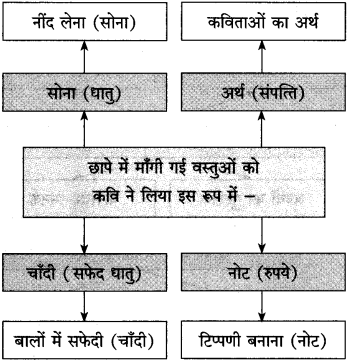 प्रश्न 4. कविता के आधार पर जोड़ियाँ मिलाइए: अ – आ अर्थ – बालों में सुवर्ण – चेहरे पर चाँदी – नई कविता में मुद्रा – काव्य कृतियों में
प्रश्न 4. कविता के आधार पर जोड़ियाँ मिलाइए: अ – आ अर्थ – बालों में सुवर्ण – चेहरे पर चाँदी – नई कविता में मुद्रा – काव्य कृतियों में 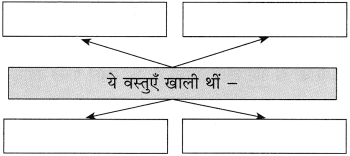 प्रश्न 2. आकृति पूर्ण कीजिए:
प्रश्न 2. आकृति पूर्ण कीजिए: 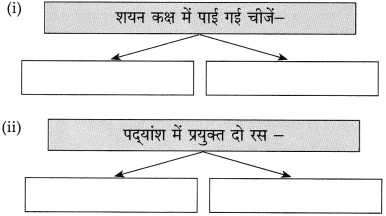 उत्तर:
उत्तर: 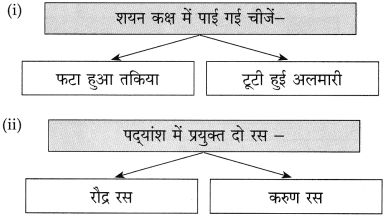 प्रश्न 3. ऐसे प्रश्न बनाइए जिनके उत्तर निम्नलिखित शब्द हों: (i) मुद्रा (ii) शयन कक्ष। उत्तर: (i) कवि ने छापा मारने वालों से अपने मुँह पर क्या देखने के लिए कहा? (ii) छापा मारने वाले कहाँ घुस गए? प्रश्न 4. आकृति पूर्ण कीजिए:
प्रश्न 3. ऐसे प्रश्न बनाइए जिनके उत्तर निम्नलिखित शब्द हों: (i) मुद्रा (ii) शयन कक्ष। उत्तर: (i) कवि ने छापा मारने वालों से अपने मुँह पर क्या देखने के लिए कहा? (ii) छापा मारने वाले कहाँ घुस गए? प्रश्न 4. आकृति पूर्ण कीजिए: 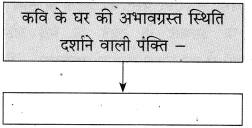 उत्तर:
उत्तर: 
 उत्तर:
उत्तर: 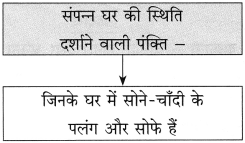 प्रश्न 2. संजाल पूर्ण कीजिए:
प्रश्न 2. संजाल पूर्ण कीजिए: 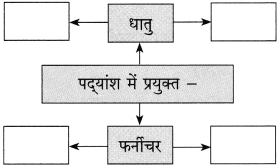 उत्तर:
उत्तर:  प्रश्न 3. ऐसे प्रश्न तैयार कीजिए, जिनके अर्थ निम्नलिखित शब्द हों: (i) पलंग (ii) धन। उत्तर: (i) परिच्छेद में सोफे के अलावा सोने-चाँदी से बनी और किस वस्तु का उल्लेख हुआ है? (ii) कवि के घर में क्या बिलकुल नहीं है?
प्रश्न 3. ऐसे प्रश्न तैयार कीजिए, जिनके अर्थ निम्नलिखित शब्द हों: (i) पलंग (ii) धन। उत्तर: (i) परिच्छेद में सोफे के अलावा सोने-चाँदी से बनी और किस वस्तु का उल्लेख हुआ है? (ii) कवि के घर में क्या बिलकुल नहीं है? 

